 |
| "The Dress." The center photo is the version that went viral. On the left and right are how that photo appears when "corrected," with the light balanced toward white and gold, and toward blue and black. |
Last weekend, after a wedding on Colonsay, a Scottish island, the bride posted a photo of the dress her mother wore. One of the members of the band noticed that most of her friends seeing the photo online thought the dress was white and gold. People seeing the actual dress at the wedding itself knew it was actually deep blue and black, but most people seeing the photo, including me, were certain it was white and gold.
“The Dress” is not the kind of optical illusion someone can stare at and eventually see both ways—most people seem to see it one way or the other, and that’s that. The reasons it appears white and gold to most people are complicated—the digital photo was badly overexposed, and thanks to some graphics algorithms that set up white balance, the resulting photo colors don’t look anything like the dress itself would in most light. And somehow our eyes seem to pick up cues from the background to add another layer to the potential for getting the color wrong.
One would think bird colors would be more straightforward than that, and they usually are, but sometimes bird colors are tricky. Most plumage colors are produced by pigments within the feathers. The main pigments in bird feathers produce shades of yellow, red, and brown to black. Pigments absorb specific wavelengths of light, and our eyes see the colors the pigments don’t absorb. A crow’s feather pigments absorb all the colors, so all we see is black. Pure white feathers have no pigments, so all the colors are reflected back as white. If you find a pigmented bird feather, such as one showing yellow, red, or black, it will look that color no matter how you hold the feather, whether light is bouncing off it or going through it.
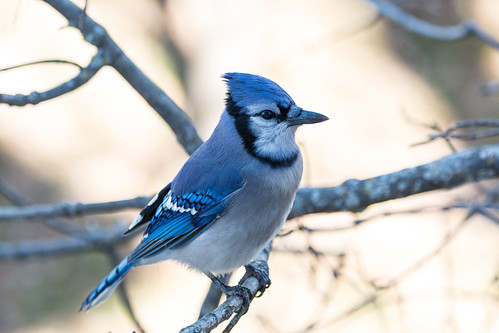 |
| This Blue Jay really is blue, along with black, white, and gray. |
Some plumage colors are not produced by pigment. Not one American bird produces blue pigment, yet the feathers of Blue Jays, bluebirds, and Indigo Buntings are truly blue, thanks to their feathers’ structure. If you’ve ever zipped feathers together, you’ve noticed that they’re made of tiny branching structures, which are beautifully patterned when seen with a magnifying glass, and even more amazing under an electron microscope. In blue feathers, the beta-keratin that gives feather barbs their strength is arranged in an intricate nanostructure with air pockets that are exactly the diameter of the wavelength of blue light. So blue light is reflected while all the other colors simply pass through or bounce off and cancel each other. If you look at a Blue Jay feather from most angles, you see the blue wavelengths that are bouncing off it, but if you hold it so light passes directly through it, you don’t see that blue reflectance. The dark pigments absorb most colors, allowing the brownish gray to bounce back to our eyes.
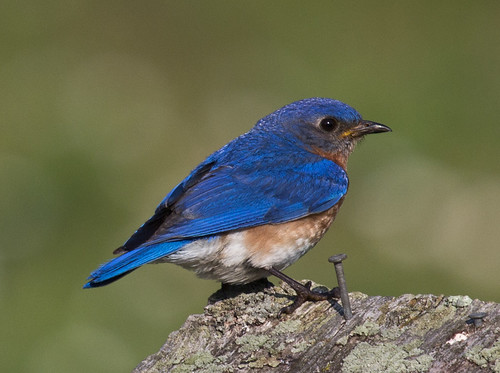 |
| Eastern Bluebird |
Some people misunderstand the issue of structural vs. pigment colors, and so I frequently hear people saying there are no truly blue feathers in birds, when of course there are. The color of anything is due to nothing more than how light bounces off it to our eyes, whether that is due to structure or pigment.
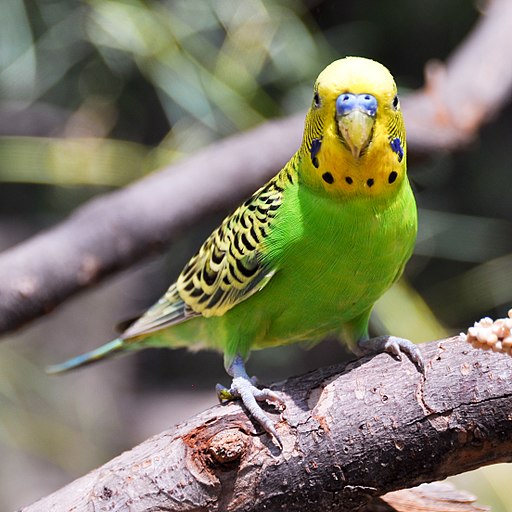 |
| Photo by Melopsittacus_undulatus_-Fort_Worth_Zoo-8a.jpg: Jerry Tillery derivative work: Snowmanradio [CC BY 2.0 (http://creativecommons.org/licenses/by/2.0)], via Wikimedia Commons |
The best example of the combination of color types is in the body feathers of pet budgies. Wild budgerigars are mostly green. The green is caused by yellow pigments absorbing all wavelengths of light except yellow, and by the blue structure of the feathers bouncing back blue while allowing other wavelengths to pass through. We see both blue and yellow in balance, making them appear green. Some budgies are selectively bred to lack the yellow pigment. They still have the blue structure, making them appear true blue. Some are bred to lack that arrangement of the beta-keratin and air pockets, and no colors are reflected by the structure. If they still produce the pigment, they appear yellow. (The head feathers of wild budgies are yellow for this reason.) Some are bred to lack both the yellow pigment and the blue structure: they appear pure white. The areas of the feathers that are black have a dark pigment (melanin) that absorbs all the wavelengths of light.
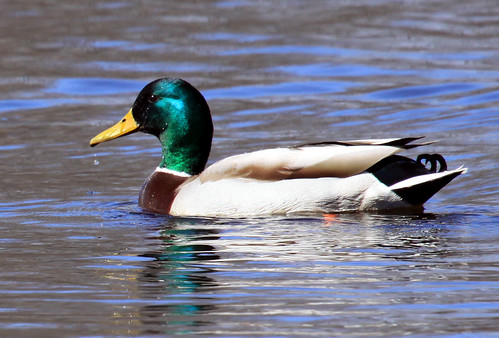 |
| Iridescent feathers on Mallard drakes usually appear green, but can take on blue or turquoise shades in some light. |
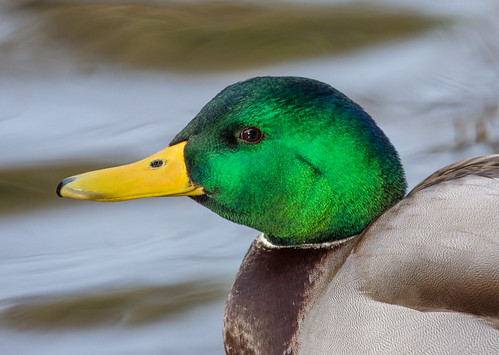
Iridescent feathers may have a simple dark pigment, but the brilliant color we see is due to structure. Unlike blue, though, we see most iridescent colors reflected only when light bounces off in a specific direction, so even the tiniest hummingbird sitting in one spot can show lots of changes in the amounts of color in the gorget as it moves its head.






